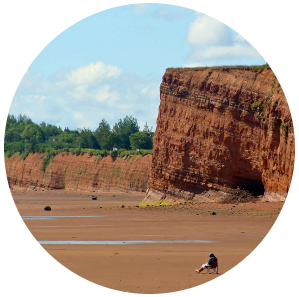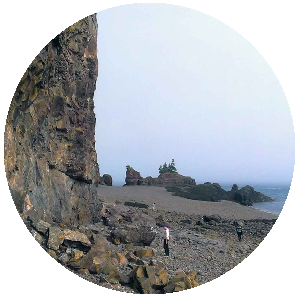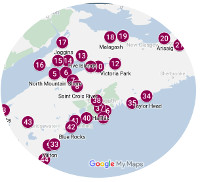- Why Mining Matters
- Jobs
- Safety
- Environment & Operations
- FAQ
- Links
- Fun Stuff
The Bay of Fundy
Bay of Fundy, home to the world’s highest tides, was first formed 250 million years ago when the continents of North America and Africa were wrenched apart. The separation of the two continents created the Atlantic Ocean and left a valley which we now call the Bay of Fundy.

The Bay of Fundy at low tide.
150 million years later, with the southern tip of Nova Scotia still joined to what we now call the State of Maine, the Fundy basin became a warm, shallow lake. However, with no replenishment of fresh water, large parts of the lake evaporated, leaving significant mineral deposits, including gypsum, salt and potash. Millions of years later, these mineral deposits were mined and these rocks are still commonly found in the rocks and cliffs of the Bay of Fundy.
As the basin dried up, heavy rains eroded the surrounding mountains and reddish rubble and sand gathered in the basin. Thick deposits of sandstone and shale resulted from the ongoing erosion, which are still visible today in the Minas Basin. The basalt cliffs at Cap d’Or, Cape Split, Digby and Grand Manan are testimony to the volcanoes of molten rock and lava which spewed from deep underground.

Partridge Island in the Bay of Fundy.
Following the last Ice Age, the Atlantic Ocean rose and filled the valley with sea water, giving us the Bay of Fundy as we know it today.
The Bay of Fundy has the highest tides in the world, and those enormous tides make the Bay one of the world’s greatest natural wonders.
The height of the tide difference ranges from 3.5 meters (11 feet) along the southwest shore of Nova Scotia and steadily increases as the tide waters travel up the 280 km of shoreline to the head of the Bay where, in the Minas Basin, the height of the tide can reach an incredible 16 meters (53 feet).
The effect of the world’s highest tides on the Bay’s shores has created dramatic cliffs and awesome sea stacks. The red sandstone and volcanic rock have been worn away to reveal fossils from over 300 million years ago.
For example, Joggins’ fossil cliffs are the world’s most outstanding example of the late Carboniferous Coal Age, a period of ancient rainforests. Along with the oldest reptiles, extinct giant trees, ferns, massive crawling millipedes, insects, and amphibians are fossilized in these cliffs, which are accessible to the public, depending on the tide.
Also, some of the earliest dinosaur fossils ever found were discovered near Parrsboro.
Further reading: https://www.bayoffundy.com/about/geology/




























































































